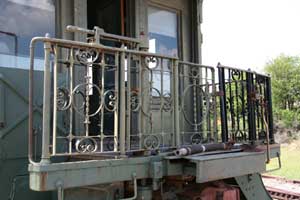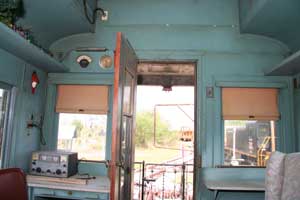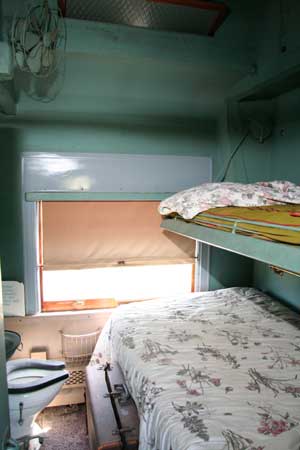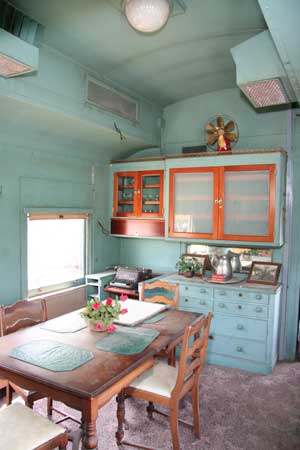The ATSF had a fleet of 18 specially built business cars for their Division Superintendents. They were heavyweight all steel cars built in the late 20s. By standardizing the parts with their other passenger cars maintenance was simplified. A total of 18 cars were purchased: 400-409, 422-429. All were built by Pullman between 5/24 and 11/29 and were 52' long with 4 wheel trucks. The best discussion will be found in Passenger Train Equipment of the Atchison Topeka & Santa Fe, Volume 2, Business and Special Purpose Cars, 1975, by Frank M. Ellington and Joseph W. Shine. The cars were numbers 422-425, PS 1924, Lot 4747
Cars 400-403 and 422-425 were 60'4" over buffers. 404-409 and 426-429 were 61.6." Cars 400, 403-406, 422, 425-429 received package type air conditioning between 1953 and 1958. Cars 400, 422, 425, 427, 429 were retired from the passenger roster in 1960. All were originally painted standard green with black roofs but in later years their roofs were painted aluminum to reflect the heat. The only one to receive roller bearing trucks, solid observation platform railing and shadowlined sides was 406. (by Joe Shine). Robert Darwin reports that 7 of the cars received shadowlining and five were ultimately converted to Foreman cars for MOW service and numbered 194008-194012 with solid silver paint. Car assignments can be found on Russell Crump's Website: in the Business & Special Purpose Cars book, p. 130. Click below to see photos of some of these cars which have been preserved. 401,
owned by ZDT's Ammusement Center in Seguin, Tx. The car is going to be turned into a snack bar called the Santa Fe Cafe. .
At the rear of the car was an Observation Platform 3'6 in depth. Next was the Observation room which was 10' long with two large windows on each side and two windows plus a door to the Observation Platform. On the rear wall was a Boyer speed recorder and a Westinghouse air gauge. Four wicker chairs with removable cushions provided moveable seating while a high back sofa in the rear of the room also doubled as an upper birth if needed.
Behind the Observation Room was Stateroom B, a 6'4" cubical to sleep 2. Behind it was a toilet and shower in 3'6", followed by State Room A, which was a spacious 7'2". In Normal inspection use, Stateroom A would be for the Division Superintendent while Stateroom B was for his secretary. For obvious reason, male secretaries were the norm for Division Superintendents.
The next room was the Dining room, 12' in length, with seating at the table for 6. A sideboard of Mexican Mahogany kept the silverware and china. A desk in the corner served the secretary, and a sofa on one wall could fold to reveal an upper birth.
A 4'4" bedroom served the porter who was also the cook in the 8' kitchen next to the vestibule. The cars were rebuilt several times during their lives. These cars were not air conditioned as constructed, but depended on clerestory roof windows for air. Various air conditioning systems were addes to different cars at different times. As built they had two vestibule doors. Very early in their lives the door on the kitchen side was closed up and a storage closet created on that side of the vestibule. As cars were modernized electric generation was added where the vestibule storage was located and a large flare vent was added to the roof. The other vestibule door was also closed in on some to create a new storage room and and a new side door created over the center of the rear truck resulting in the loss of one vestibule side window. While on the road, a generator hung on the rear truck provided the power for the car. The memoirs of Harry J. Briscoe are recorded in "Watching the Trains Go By…" published by the Santa Fe Railway Historical and Modeling Society. Briscoe introduced the 400 series cars by saying: "In those days every Division Superintendent was provided with a business, or office, car. Santa Fe's were the 400 series, having a master bedroom and a secretary's room. Here was the real reason for the widespread use of male secretaries. The Superintendent visited all parts of his territory by placing his business car on the rear of the train, either passenger, local, or short through freight. While seated at his desk in the small living room at the rear, he could look through the rear window and observe every portion of his division. He could have other division officers accompany him and discuss track conditions, bridges, drainage, weeds, fences, etc. When meeting trains, or passing through yards he could observe the compliance with the various operating rules on the part of train service or station employees. The crew consisted of a cook who was also the porter and housekeeper. The Superintendent and his secretary slept on the car in small staterooms, as did the cook-porter in his own quarters. A mail bag was sent from headquarters on another train which would be picked up by the secretary and the mail would be worked during the evening hours. Then the secretary would take the bag to the depot to be returned to the office on the next available train. The dining room area in the middle of the car had a small desk that held a fold-down typewriter well. Any dictated correspondence would be typed by the secretary either while the car was stationary or moving. Should it be necessary to send a telegram, all secretaries took pride in their ability to roll the telegram in a tight funnel shape, weight the pointed end with a paper clip, and throw it off the rear platform of the fast-moving train, landing it at the foot of the operator, who was required to be on the platform inspecting the train as it passed." He also reports that when the car was used in emergencies or on bridge inspections, other members of the Superintendent's staff could be housed and fed on the car using the extra berths in the observation and dining rooms. The cars were also used to take local dignitaries to special events. Briscoe was Eastern Division Superintendent in Emporia from 1962-69. He reports that when he was transferred from Wellington to Emporia, he lived on the 404 while his family remained in Wellington until school was out. His porter-chef, Arthur, lived in Topeka and would drive down twice a week to clean and stock the car or to go with him if the car was going out on the line. He also stated, "Periodically it was my custom to put business car 404 on the rear of our local passenger train No. 4, and go to Kansas City Union Station via the Second District, taking along the Division Engineer, now Al Ewert… We would check the riding qualities of the track, inspect the right of way, and observe freight train traffic. It occurred to me that Mr. (William L.) White might enjoy such a trip, so I invited him. He readily accepted. No. 4 was scheduled to leave Emporia just before noon so we had opportunity for a nice lunch before we were placed on the rear of the train… We were to return the same afternoon on the rear of No. 11, which used the First District through Lawrence and Topeka, so this trip allows us a fast look at all of our main line operations. I had no idea Mr. White would write about the trip, but he did a series of six articles on the editorial page. By great coincidence, this was the last trip of the business car. Shortly thereafter (1968) the Superintendents' business cars were discontinued and were replaced by a High Rail automobile, equipped to run on the railroad track. Mr. White closed his series with this report: 'The dance is over. The curtain has come down. Poor Harry Briscoe has been whittled down to size. The Santa Fe has sent orders thundering out of Chicago that, as an economy measure, its division superintendents must give up their private cars. And what will happen now that Al Ewert can no longer take his notes? Let them worry about that in Chicago.'" Click for models of these cars.
|












